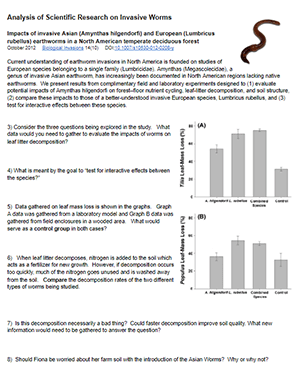
Snake worms, jumping worms, crazy worms… all names to describe a group of worms in the Amynthas group. These worms appeared recently in North America and have a distinct movement that differs from the already established Lumbricidae worms. Incidentally, European earthworms are common to North America but they were not originally on the continent. We usually talk in terms of invasive species as having negative impacts on the environment. This is a good time to open up discussions about non-native organisms that have positive impacts, such as earthworms and apple trees.
The real question here is whether farmers, foresters, or gardeners should be concerned about the jumping worm. Their wiggly movements might be disconcerting, but will they harm the environment? Students will attempt to answer the question by examining primary literature, analyzing data, and exploring information about the jumping worm. At this point, information on the worm is somewhat limited, with a few studies that may suggest that the worms harm the environment by consuming leaf litter too fast.
This is a great way to get students more involved in their local environment. I usually bring earthworms from a bait store and have students examine physical features. If possible, you might even be able to get samples of Asian jumping worms to compare.

Crazy Worm Lesson Guide
This lesson can be a short stand-alone activity where students examine data, or it can be a longer assignment in an ecology unit. For example, I use the 5E model for lessons that encompass big ideas. In this case, the big idea is about species diversity.
Engage – Show students a video or gif of the Asian worms. Ask them HOW the worms appear different from the European worms. Ask them how the worms got into North American soil.
Explore – Ask students to discuss the problem with invasive species and to design how they could test the impacts of Asians worms on forests and farmlands.
Explain – Students review information sources to learn more about the Asian jumping worm. If possible, I group students and have each review a different source and then share with the class. Post-its are my favorite way to share information between groups. You can set up a board where students write observations and data from their reading.
- “Cancel Earthworms” by Julia Rosen; The Atlantic
- “Earthworms: Can these gardeners’ friends actually become foes” by Science News for Students
- “Asian Jumping Worm” by Nebraska Invasive Species Program
- “Research Update: Jumping Worms and Sleeping Cocoons” by Arboretum of University of Wisconsin
- “Jumping Worms: The Creepy, Damaging Invasive You Don’t Know” by Cool Green Science
- “Invasive Jumping Worms Damage U.S. Soil and Threaten Forests” by ScienceNews
- “Look Out for Jumping Earthworms” by Penn State Extension
- “Invasion of the Jumping Worms” Podcast by Unexplainable (25 min)
- “The Trouble with Earthworms” audio from NPR (15 min)
Elaborate – Here, they can do the data analysis from a peer reviewed study. The worksheet is not a full printout of the journal article, but you could certainly share that for authenticity. Once students have analyzed what is known, the focus should switch to what is not known. Students can plan further investigations to answer the question or determine if the jumping worms are really a problem.
Evaluate -Students present this summary in formats like a concept map, a short video (TikTok), fact sheet, or an essay. You could even share this video as an inspiration for their own creation. Caution: giving too much away for the artifact at the beginning might make it more difficult for students to develop their own creativity.

